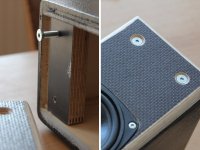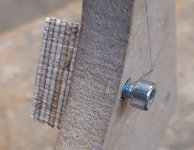Cal, I edited my post.
The image was a copy off the net. Did not realize it was a backward nut.
Sorry for the confusion.
Please delete or edit using your privileges.
The image was a copy off the net. Did not realize it was a backward nut.
Sorry for the confusion.
Please delete or edit using your privileges.
I am just amazed they don’t have someone on hand to point out the obvious. Reminds me of the lady holding an energized part of the soldering iron while advertising for a technology institute.
And no you don’t want felt washers. They will introduce a discontinuous seal. What can be used is a gasket. It can be made of any number of things but Its primary purpose will be air seal rather than damping or isolation.
And no you don’t want felt washers. They will introduce a discontinuous seal. What can be used is a gasket. It can be made of any number of things but Its primary purpose will be air seal rather than damping or isolation.
Last edited:
I use little pieces of birch plywood glued firmly inside the baffle, cut metal threads and insert metal screws. This is very solid, even after several times of screw loosening and tightening again. In my experience T-nuts tend to get loose after some screw loosening/tightening cycles, specially in mdf.
There are some furniture accessories that look like a nut welded or riveted to a small plate of metal.
You can glue them to the speaker body, from the back of the hole, the metal will distribute the force of the screw on the board.
As for gaskets / vibration isolators, the speaker experts here will be much better informed than I am...please take their advice.
You can glue them to the speaker body, from the back of the hole, the metal will distribute the force of the screw on the board.
As for gaskets / vibration isolators, the speaker experts here will be much better informed than I am...please take their advice.
A very good idea but it takes more time and often requires longer driver mounting screws. Not to mention potential for future fastener back-out.I use little pieces of birch plywood glued firmly inside the baffle,
Well I this case is not MDF but plywood ,I use little pieces of birch plywood glued firmly inside the baffle, cut metal threads and insert metal screws. This is very solid, even after several times of screw loosening and tightening again. In my experience T-nuts tend to get loose after some screw loosening/tightening cycles, specially in mdf.
Can you elaborate more on the cut metal threads in the wood, does a metal screw works just fine in wood?
Does normal wood glue works fine to attach metal thread inserts for metal screws ?
Also if I turn the driver so the magnet is facing the mouth , that will easy vibration or get a lower freq response ?
hi @maxolini
one more picture of metal screws in plywood used to attach a baffle to the box.
the screws are metric M5, plywood is 12 mm thick.
i drilled a 4 mm hole before cutting the thread (the hole can and should be smaller than the suggested diameter for metal).
the screws sit quite tight and can also be fastened tightly.

plywood obviously has to be strong and allow cutting of the metal thread, so birch plywood works best in my experience.
in your case (case made of plywood) it might be possible to cut threads directly into the baffle. I suppose it will be difficult to use the existing holes, so the suggestion to rotate the drivers is probably best!
one more picture of metal screws in plywood used to attach a baffle to the box.
the screws are metric M5, plywood is 12 mm thick.
i drilled a 4 mm hole before cutting the thread (the hole can and should be smaller than the suggested diameter for metal).
the screws sit quite tight and can also be fastened tightly.

plywood obviously has to be strong and allow cutting of the metal thread, so birch plywood works best in my experience.
in your case (case made of plywood) it might be possible to cut threads directly into the baffle. I suppose it will be difficult to use the existing holes, so the suggestion to rotate the drivers is probably best!
I don't think so,Does normal wood glue works fine to attach metal thread inserts for metal screws ?
I use Bison Tix, a gel type contact glue, from a tube for easy dosing. I apply it on t-nuts and use it directly, without letting it get to a tacky state first. Then I pull in the t-nut with a hex bolt, with a large M6 washer between the baffle and the bolt head. If possible I pre-drill the holes for M6 t-nuts with a 7.5 mm drill.
Haven't had a failure yet.
Don't know why it would easy vibration but it can slightly alter the frequency response, to drop lower.Also if I turn the driver so the magnet is facing the mouth , that will easy vibration or get a lower freq response ?
- Home
- Loudspeakers
- Subwoofers
- Screws getting loose on a driver and one damaged thread
